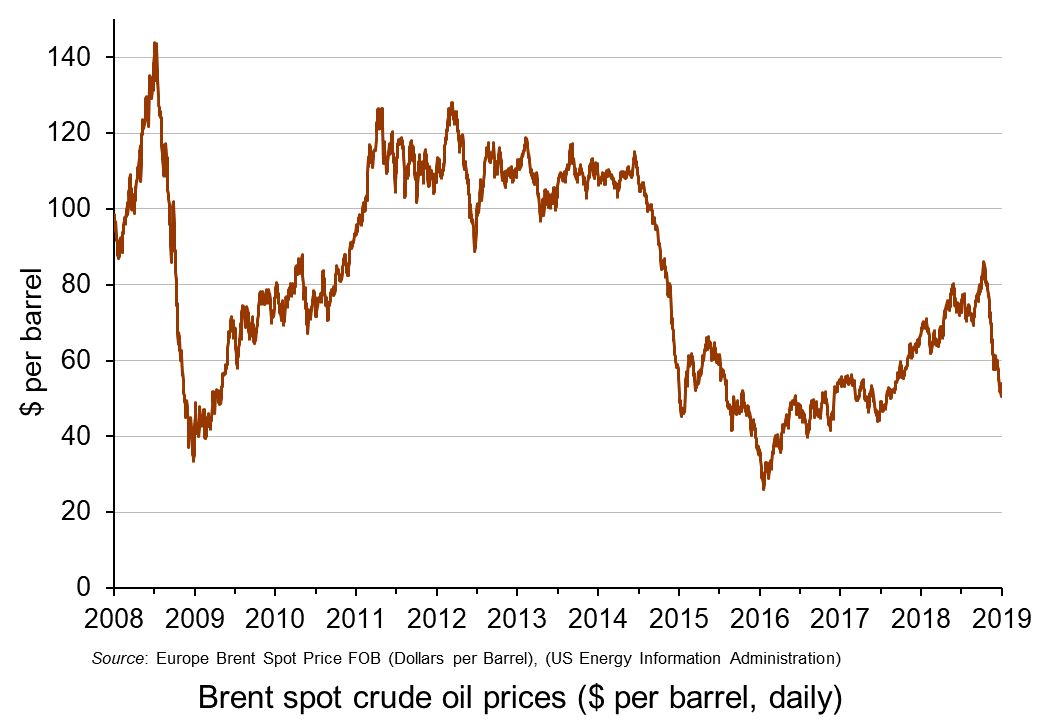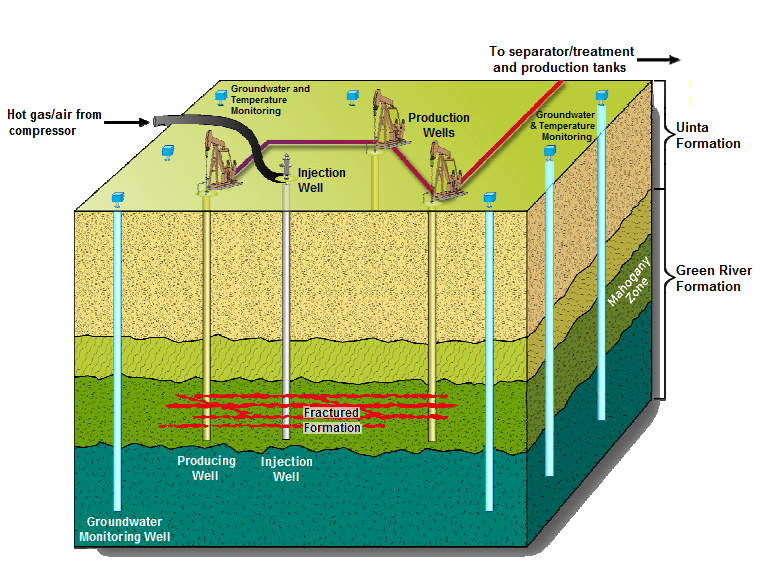Oil prices: the ups and the downs
 Back in October, we examined the rise in oil prices. We said that, ‘With Brent crude currently at around $85 per barrel, some commentators are predicting the price could reach $100. At the beginning of the year, the price was $67 per barrel; in June last year it was $44. In January 2016, it reached a low of $26.’ In that blog we looked at the causes on both the demand and supply sides of the oil market. On the demand side, the world economy had been growing relatively strongly. On the supply side there had been increasing constraints, such as sanctions on Iran, the turmoil in Venezuela and the failure of shale oil output to expand as much as had been anticipated.
Back in October, we examined the rise in oil prices. We said that, ‘With Brent crude currently at around $85 per barrel, some commentators are predicting the price could reach $100. At the beginning of the year, the price was $67 per barrel; in June last year it was $44. In January 2016, it reached a low of $26.’ In that blog we looked at the causes on both the demand and supply sides of the oil market. On the demand side, the world economy had been growing relatively strongly. On the supply side there had been increasing constraints, such as sanctions on Iran, the turmoil in Venezuela and the failure of shale oil output to expand as much as had been anticipated.
But what a difference a few weeks can make!
 Brent crude prices have fallen from $86 per barrel in early October to just over $50 by the end of the year – a fall of 41 per cent. (Click here for a PowerPoint of the chart.) Explanations can again be found on both the demand and supply sides.
Brent crude prices have fallen from $86 per barrel in early October to just over $50 by the end of the year – a fall of 41 per cent. (Click here for a PowerPoint of the chart.) Explanations can again be found on both the demand and supply sides.
On the demand side, global growth is falling and there is concern about a possible recession (see the blog: Is the USA heading for recession?). The Bloomberg article below reports that all three main agencies concerned with the oil market – the U.S. Energy Information Administration, the Paris-based International Energy Agency and OPEC – have trimmed their oil demand growth forecasts for 2019. With lower expected demand, oil companies are beginning to run down stocks and thus require to purchase less crude oil.

On the supply side, US shale output has grown rapidly in recent weeks and US output has now reached a record level of 11.7 million barrels per day (mbpd), up from 10.0 mbpd in January 2018, 8.8 mbpd in January 2017 and 5.4 mbpd in January 2010. The USA is now the world’s biggest oil producer, with Russia producing around 11.4 mpbd and Saudi Arabia around 11.1 mpbd.
Total world supply by the end of 2018 of around 102 mbpd is some 2.5 mbpd higher than expected at the beginning of 2018 and around 0.5 mbpd greater than consumption at current prices (the remainder going into storage).
So will oil prices continue to fall? Most analysts expect them to rise somewhat in the near future. Markets may have overcorrected to the gloomy news about global growth. On the supply side, global oil production fell in December by 0.53 mbpd. In addition OPEC and Russia have signed an accord to reduce their joint production by 1.2 mbpd starting this month (January). What is more, US sanctions on Iran have continued to curb its oil exports.
But whatever happens to global growth and oil production, the future price will continue to reflect demand and supply. The difficulty for forecasters is in predicting just what the levels of demand and supply will be in these uncertain times.
Articles
- What’s Got Oil So Spooked? It’s the Economy, Stupid
- Why Trump taking credit for low gas prices is a bad idea
- Oil rises on China-U.S. talks, gains capped by U.S. fuel build
- Oversupply, faltering growth to weigh on oil prices in 2019: Reuters poll
- $70 Oil Could Be Right Around The Corner
Bloomberg, Julian Lee (23/12/18)
Vox, Emily Stewart (3/1/19)
Reuters, Stephanie Kelly (4/1/19)
Reuters, Brijesh Patel (31.12.18)
Bloomberg, Tim Daiss (31.12.18)
Video
 Oil prices decline on swelling oversupply, volatile markets
Oil prices decline on swelling oversupply, volatile markets
Reuters, Pascale Davies (3/1/19)
Data
- US crude oil production
- Brent crude prices
- Short-term Energy Outlook: Global liquid fuels
- Short-term Energy Outlook: World liquid fuels production and consumption balance
US Energy Information Administration
US Energy Information Administration
US Energy Information Administration
US Energy Information Administration
Questions
- Identify the factors on both the demand and supply sides of the oil market that have affected prices recently.
- What determines the amount that changes in these factors affect the oil price?
- What determines (a) the price elasticity of demand for oil; (b) the income elasticity of demand for oil; (c) the price elasticity of supply of oil?
- Why might oil prices overshoot the equilibrium price that reflects changed demand and supply conditions?
- Use demand and supply diagrams to illustrate (a) the destabilising effects that speculation could have on oil prices; (b) a stabilising effect.
- Is the holding or large stocks of oil likely to stabilise or destabilise oil prices? Explain.
- What will determine the likely success of the joint OPEC/Russian policy to support oil prices by reducing supply?